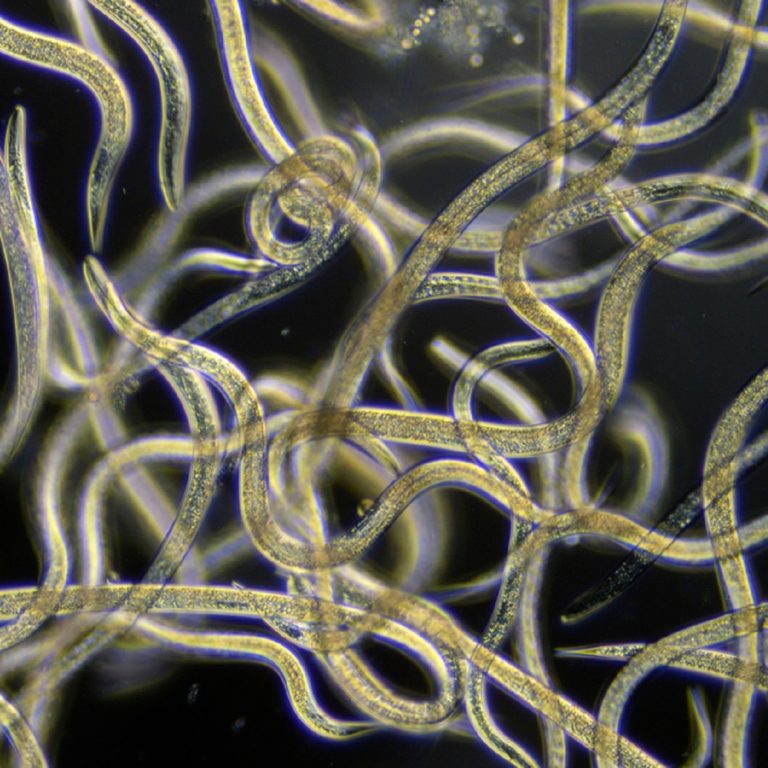Talking about parasites can be unpleasant – even scary. But living in denial, and thinking that parasites do not exist in the human body that much, or that they cannot do us any harm, can lead to misdiagnosing several common health issues.
Thus, let’s not deny these tiny invaders anymore, and talk about this unpleasant topic. Parasites exist, and it is estimated that the majority of people may have parasites in their bodies. Moreover, up to 100 different species of parasites can nest in one person at a time.
Sadly, sometimes it’s difficult to notice their presence, as the symptoms of parasitic activity may seem to be, for instance, the flu virus.
The traditional healers knew about parasites thousands of years ago and cleansed the body regularly with various plants and herbs obtained from the home yard, such as wormwood, pumpkin seeds, garlic, dandelion, etc. There is not much information out there about how to naturally cleanse your body from parasites, and the lack of knowledge can cause a lot of damage.
On the other hand, awareness about parasites, with what and how you can naturally get rid of parasites from your body, allows you to protect yourself with preventive actions.
So hereby, we bring more light to this subject and discuss the most common types of parasites, how to know if you might have parasites in your body, what diseases they can cause, and most importantly – how to eliminate parasites naturally.

How Do You Get Parasites and What Are The Risk Factors?
The likelihood of parasitic infections has also risen with the increased traveling, as the tropical climate in the South increases the number of parasites. Luckily in the Nordic countries, the prevalence of some types of parasites is not that common and is controlled by minus degrees. Though you may still get parasites from all around the world from anywhere, for instance:
- Eating raw or semi-raw meat or fish.
- Being in contact with pets.
- Contaminated water or food (poor sanitation).
- Poor hygiene.
- Unwashed hands.
- Unwashed vegetables and fruits.
- Doctors and especially pediatricians are also exposed to parasites, as their patients often have parasites.
- Institutional care centers.
- During traveling to a region known to have parasites (mostly rural or developing countries).
- Living in regions known to have parasites.
- Elderly people and children are more vulnerable to parasitic infections.
- Weakened immune system.
- HIV or AIDS (3).
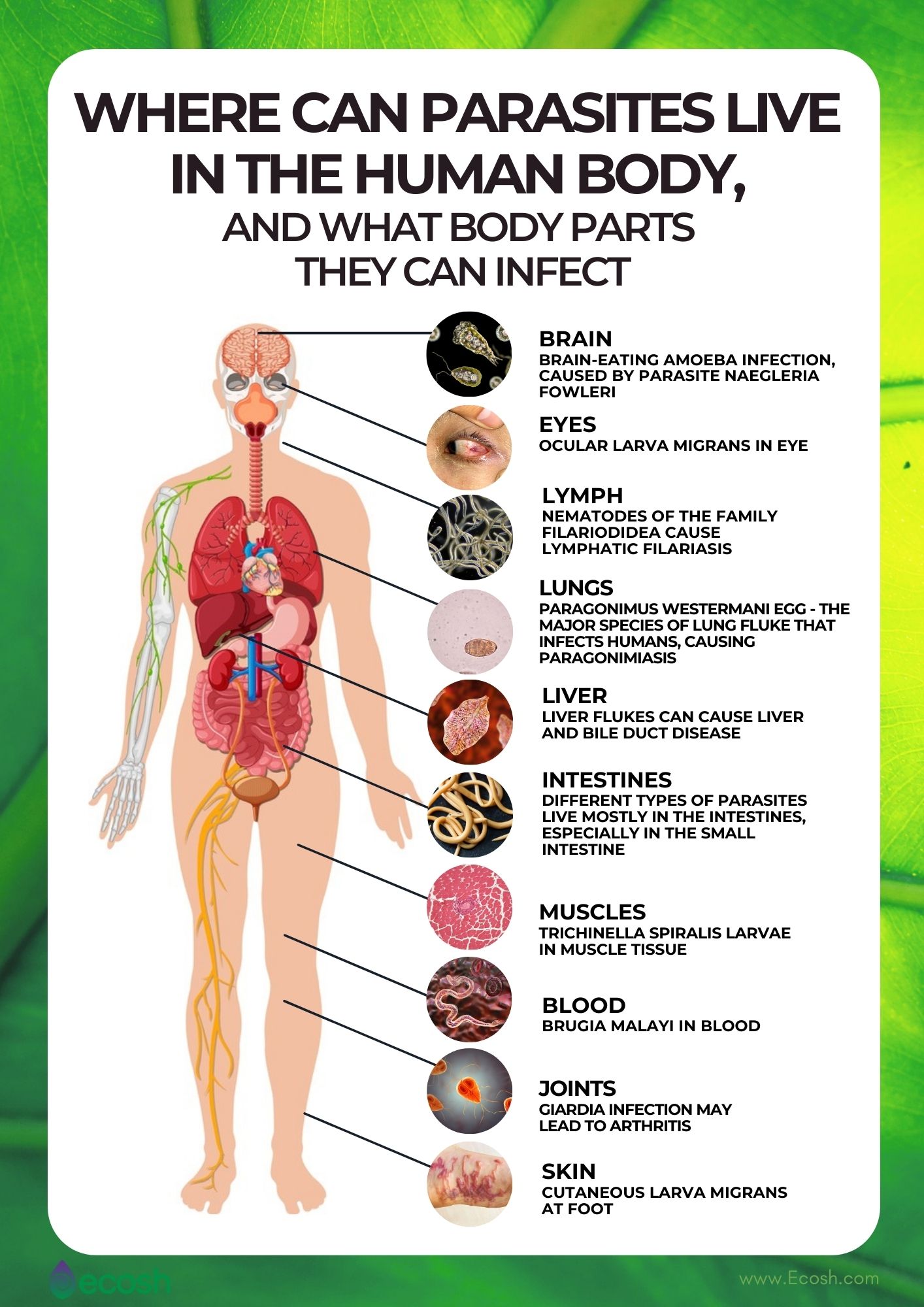
Where Do Parasites Live In The Human Body?
Parasites can live for decades and multiply at a catastrophic rate. Some parasites adapt so well that humans do not feel their presence of them at all. So, despite strictly following the rules of personal hygiene, drinking only boiled water, washing fruits thoroughly, and not eating raw food such as meat, fish, fruits, or veggies, there is still a possibility of getting some type of parasites each day.
In humans parasites may live in several places and infect many body parts and organ systems, for instance:
- Lungs (for example lung flukes).
- Muscles (for example Trichinella spiralis larvae).
- Joints (Giardia lamblia infection may lead to later development of arthritis).
- Blood (for example Brugia).
- Lymph (for example nematodes of the family Filarioidea).
- Brain (For example, brain-eating amoeba infection is caused by parasite Naegleria fowleri).
- Liver (for example liver flukes).
- Skin (for example, ectoparasites such as mites, lice, ticks, chiggers, scabies, mosquitoes, tsetse flies, fleas, and bed bugs, but also cutaneous larva migrans).
- Eyes (for example Ocular larva migrans)
- But mostly in the intestines, especially in the small intestine, where the main absorption of nutrients takes place (for example all helminths).

Signs That You May Have Parasites
The number of intimidating parasitic infections and diseases has escalated rather than decreased in the last decade. Some say that the majority of people have some kind of parasitic organism in their bodies and they don’t know it.
One of the reasons why people don’t get well and get sick over and over again might also be due to parasites that live and rapidly multiply in the body. Parasites (intestinal) consume the waste products deposited in your body, as well as the minerals and vitamins that a person needs to function. One of the first signs that a person may have parasites is a lack of vitamins and minerals in the body.
In addition, these foreign toxins produced by the metabolism of parasites destroy the cells of the host, and cause damage to organs. Thus, having some kind of parasitic infection mostly leads to the lack of nutrients, disturbances in hematopoiesis and hormonal balance, pathological changes in blood vessels, and a weakened defense mechanisms against cancer.
Signs and symptoms generally occur in stages, and can vary from person to person – some symptoms may progress rapidly over days and weeks, others may quietly sneak up over months and even years. The time it takes for symptoms to reveal or how severe they are depends on how well your body can fight and stay in balance, or whether some other type of parasites already lives in the body.
Moreover, you may not even notice the presence of parasites, as the health problems they cause are usually similar to the common cold, flu, arthritis, rheumatism, indigestion, and other conditions.
Symptoms And Signs Of The Residence Of Parasites May Include:
- Nocturnal salivation (drooling during sleep).
- Gnashing of teeth.
- Evening sweets rush.
- Abdominal pain after eating pumpkin seeds.
- Dark rings around the eyes.
- Refractory anemia.
- Lack of trace elements.
- Indigestion.
- In children, parasites are expressed by itching of the anus around ten o’clock in the evening, as worms (eg mallards – 1 cm) come out to lay eggs.
- Low immunity.
- Tiredness.
- Restlessness.
- Depression.
- Memory gaps.
- Pain.
- Headache.
- Salt cravings.
- Dizziness.
- Rash, and pimples on the skin.
- Increased mucus and skin secretion.
- Itching.
- Cough.
- Runny nose.
- Hair loss – baldness and dandruff.
- Nails flaking and break.
- Sometimes with fever.
- Inflammation of the muscles and joints (arthritis).
- Problems with sleeping (snoring, insomnia, frequent awakenings, gnashing of teeth, twitching during sleep).
- Menstrual irregularities.
- Heart attacks.
- Diarrhea or constipation.
- Vomiting.
- Bloating.
- Flatulence.
- Fatigue.
Travel Infection – Signs And Stages Of Development
When you are infected with some type of parasite during traveling, the infection manifests itself in the following symptoms and stages (these stages do not only apply to parasites you may get during the journey):
- Stage I. The primary sign of parasite infection is fatigue in the morning after eating fruit, which occurs about 20 minutes after eating (as sugar is the food source for parasites). Regaining from this fatigue or weakness only takes about 1-2 hours. In addition, it can also affect you psychologically – you may experience more negativity and fluctuating mood.
- Stage II. As the problem aggravates, you may experience abdominal pain, gas, as well as diarrhea. If in the first stage the sudden fatigue was caused by eating sugars, then later your body may already react to every food, especially raw foods.
- Stage III. Later in the third stage, you may experience certain types of unpleasant-smelling belching (burping) and gases (the release of sulfur compounds produces a smell similar to a rotten egg). The loss of strength after eating continues. The stool becomes liquid, which, as the infection progresses, can become chronic and change color from yellow to green with characteristic strange odors. However, it is still possible to treat this kind of infection at home with herbal remedies and proper nutrition. Though, it’s not recommended, because it’s always best to seek medical help from professional doctors.
- Stage VI. Diarrhea (liquid stools) leads to immense loss of fluid, accompanied by symptoms such as fever, imbalance, dizziness, weakness, and cramps. Thus, your body does not get anything necessary to function, not even water – everything comes out through vomiting or diarrhea. At this stage, you need to act quickly and go to the hospital, as the parasites have already taken over your body. These types of infections are characteristic due to parasites from southern journeys.

What Do Parasites Eat?
Parasites consume the same food that enters your body – meaning, they eat what you eat – primarily essential nutrients also for humans (including vitamins, trace elements, etc.). In addition, also the body’s tissues, cells, blood, and waste products.
This, however, may lead to a deficiency of the necessary substances in the body, a significant decrease in the intake of proteins, fats, vitamins, and minerals, damage to the lymph nodes, intestines, liver, bile ducts, skeletal muscles, central nervous system, weakened immune system, and disrupted self-medication processes.
What Diseases Can Parasites Cause?
If parasites preoccupy around 10% of the body, the body is no longer able to excrete all of its toxic feces. Blood transports the toxic remnants of parasite activity into the whole body and stores these unwanted leaves, depending on the person, in the lungs, stomach, mammary glands, or elsewhere.
Every third person (including children) in Europe has parasitic diseases. Diathesis and allergies in infants are thought to be related to the transmission of parasites from mother to child, often during pregnancy. Thus, it might be a good idea to cleanse the body from parasites before planning pregnancy.
Some Common Infections And Health Conditions Caused By Parasites Include:
- Allergies.
- Anemia.
- Eczema.
- Hepatitis.
- Cardiovascular disease (myocarditis, including stroke and infarction).
- Migraine.
- Pneumonia.
- Scoliosis.
- Dysbacteriosis.
- Multiple sclerosis.
- Joint pain, and arthritis (caused by Giardia).
- Lymphatic filariasis (caused by 3 species of worm nematodes (roundworms) of the family Filarioidea).
- African trypanosomiasis, babesiosis, leishmaniasis, and malaria.
- E. vermicularis (caused by pinworm).
- Epidermal parasitic skin diseases (EPSD) such as scabies, pediculosis (capitis, corporis, and pubis), tungiasis, and hookworm-related cutaneous larva migrans.
- Chagas disease (caused by Trypanosoma cruzi).
- Echinococcosis (caused by another tapeworm, passed through dogs and sheep).
- Cysticercosis (caused by tapeworm).
- Toxocariasis (caused by roundworm).
- Trichomoniasis, a sexually transmitted infection (caused by infection with a protozoan parasite Trichomonas vaginalis).
- Paragonimiasis (caused by Paragonimus westermani, which is the major species of lung flukes that infect humans).
- Amebiasis (infection of the intestines caused by a parasite (amoeba) Entamoeba histolytica).
- Diseases of all gastrointestinal tract.
- Cysts (a small closed cell sachet) that are usually filled with a liquid or semi-solid substance, including pus, etc. The cyst is isolated from the normal bloodstream, making it difficult to treat the cyst with conventional medicines.
- In the case of echinococcosis (caused by tapeworms of the Echinococcus type) and alveococcosis of the liver (a common parasitic disease) – surgery might be needed.
- Helminthiasis is a disease caused by intestinal worms. Intestinal nematodes are parasites that live in the intestines of humans and animals or other parts of the body (eg liver, eyes). Intestinal nematodes secrete harmful substances that, when absorbed into the bloodstream, gradually poison the human body.
Therefore, someone who is infected weakens, develops anemia, headaches, nausea, vomiting, and indigestion. Often the appetite decreases, the patient becomes thinner, weaker, gets tired more quickly, and the ability to work decreases
- Hymenolepiasis (caused by two tapeworm species, Hymenolepis nana (the dwarf tapeworm), and Hymenolepis diminuta (rat tapeworm).
- Schistosomiasis. This is caused by blood flukes (Schistosoma) that infect more than two million people worldwide.
- Taeniasis is an intestinal infection caused by 3 species of adult tapeworm: Taenia solium (pork tapeworm), Taenia saginata (beef tapeworm), and Taenia Asiatica.
- Toxoplasmosis. This infection is caused by a single-celled parasite called Toxoplasma gondii. While the parasite is found throughout the world, more than 40 million people in the United States may be infected with the Toxoplasma parasite.
- Fascioliasis. This infectious disease is caused by the trematode Fasciola. This parasite (liver fluke) is endemic in many parts of the world including countries from Asia, Africa, Europe, and the Americas. It has been suggested that there might be a link between F. hepatica infection and liver fibrosis (1, 2, 3, 14, 15, 16, 20, 21, 22, 23, 24).
Many Multicellular Parasites Can Also Mechanically Damage The Host:
- Damage to gastrointestinal tissues (tapeworms, pinworms).
- Intestinal clogging and blockage (tapeworms, nodules).
- Obstruction of the bile duct (nodules, hepatobiliary).
- Hepatic necrosis (accumulation of blood flukes (Schistosoma) eggs or larvae in the liver).
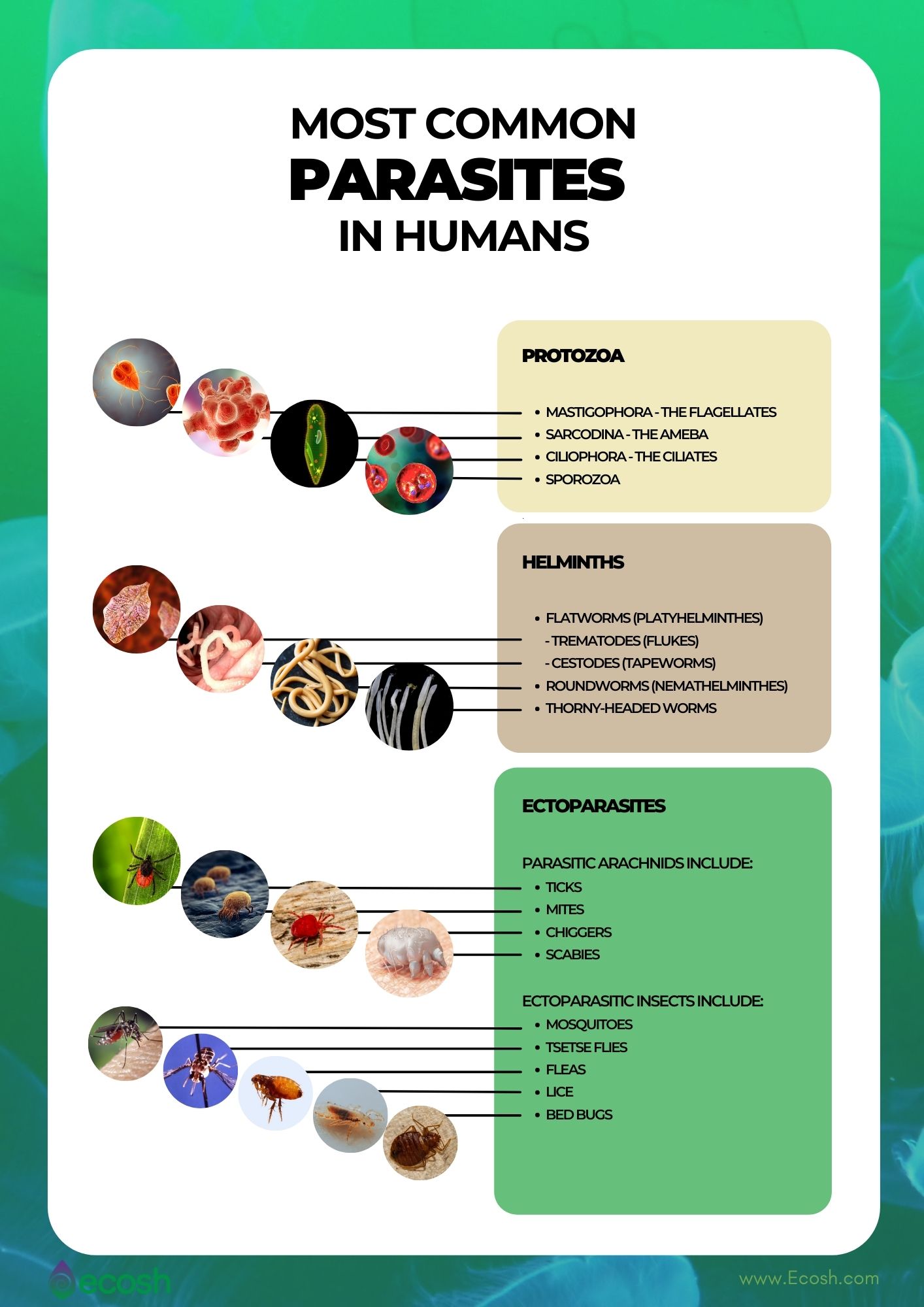
Classification Of Parasites – The Full List of Most Common Parasites That Live In The Human Body
There are hundreds of different species of parasites in the world. Parasites living in the human body can range in size from micrometers to several meters. These three main classes of parasites that can cause diseases in humans are protozoa (unicellular), helminths (multicellular), and ectoparasites (multicellular).
1. Class – Protozoa
Protozoa are microscopic, one-celled organisms that can be free-living (meaning they feed on bacteria, algae, other protozoans, or organic debris) or parasitic. It can multiply in humans, which permits severe infections to develop from just a single organism.
Transmission of protozoa
- Intestinal protozoa. Transmission of protozoa that live in a human’s intestine to another human usually happens through a fecal-oral route (for example, contaminated food or water or person-to-person contact).
- Blood and tissue protozoa. Protozoa that live in the blood or tissue of humans are transmitted to other humans by an arthropod vector (for example, through the bite of a mosquito or sandfly).
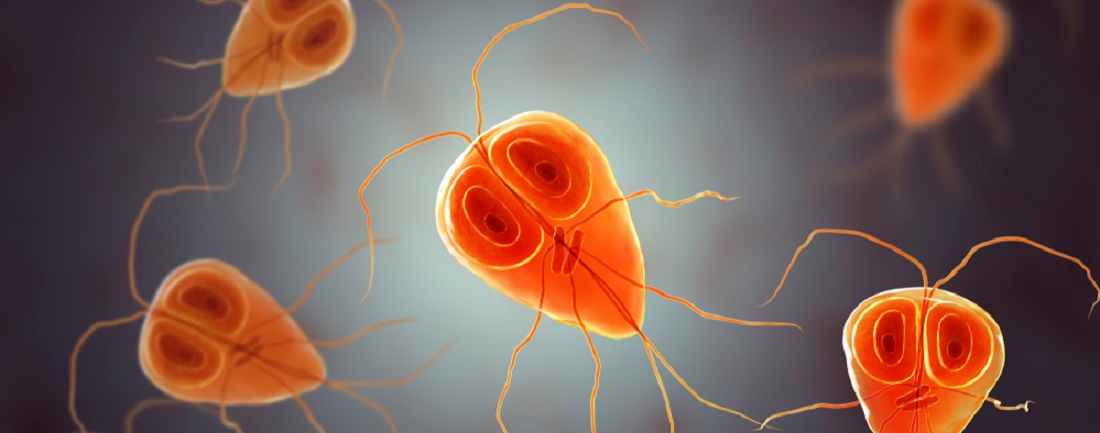
The protozoa that are infectious to humans can be classified into 4 groups based on their mode of movement:
1. Mastigophora – the flagellates (a cell or organism with one or more whip-like appendages called flagella), such as:
- Giardia (causes the diarrheal disease giardiasis)
- Leishmania (causes parasitic disease Leishmaniasis)
- Trypanosomes (Trypanosomes cause sleeping sickness (African trypanosomiasis) and Chagas disease (American trypanosomiasis))
2. Sarcodina – the ameba (a single-celled animal that catches food and moves about by extending fingerlike projections of protoplasm), such as:
- Entamoeba histolytica (causes amebiasis (amebic dysentery) that kills around 100,000 people each year)
3. Ciliophora – the ciliates (a single-celled animal characterized by the presence of hair-like organelles called cilia, which are identical in structure to eukaryotic flagella, but are in general shorter and present in much larger numbers, with a different undulating pattern than flagella), such as:
- Balantidium (may cause persistent diarrhea, abdominal pain, and sometimes a perforated colon in people with other serious illnesses)
4. Sporozoa (one-celled, non-motile, parasitic, and spore-forming. Most of them have an alternation of sexual and asexual stages in their life cycle), such as:
- Plasmodium falciparum (the type of malaria that most often causes severe and life-threatening malaria)
- Cryptosporidium (causes cryptosporidiosis – watery diarrhea)
- Sporozoa include also the organisms that cause babesiosis, coccidiosis, and toxoplasmosis (4, 5, 6, 7).

2. Class – Helminths
Parasitic worms, also known as helminths (derived from the Greek word for worms), are large multicellular organisms that can usually be seen with the naked eye in their adult stages. Similar to protozoa, helminths can also be parasitic or free-living. In their adult stage, these parasitic worms cannot multiply in humans. Many of those are intestinal worms that are soil-transmitted and infect the gastrointestinal tract. Other parasitic worms such as schistosomes live in blood vessels. Three main groups of helminths are human parasites:
1. Flatworms (Platyhelminthes)
Flatworms are a phylum of quite a simple bilaterian, unsegmented, soft-bodied invertebrates (an animal that lacks a vertebral column, or backbone). In the human body, they usually infect the gastrointestinal tract or the liver. Types of flatworms in humans include:
Trematodes (flukes)
Adult trematodes have two specialized suckers, and the larvae and adult stages can suck their food from their host by grabbing on with their powerful mouths. They also expel undigested material through their muscular mouth as they do not have an anus. Trematodes can infest various organs (liver, blood, lungs) in a wide variety of animals and are some of the most harmful parasites of humans.
For example, blood flukes (Schistosoma) infect more than 2 million people worldwide with a disease called schistosomiasis. People can become infected by working, bathing, or swimming in water containing mollusks such as snails that carry the flatworms.
Cestodes (tapeworms)
In humans, tapeworm infections are mostly caused by Taenia solium (pork tapeworm), Taenia saginata (beef tapeworm), Hymenolepis nana (dwarf tapeworm), Taenia Asiatica (Asian pork tapeworm), Diphyllobothrium (fish tapeworm), and Echinococcus granulosus, also called the hydatid worm (dog tapeworm).
The Tapeworm develops into adulthood in about a month and can live up to 30 years. In the small intestine, an adult worm attaches to the intestinal wall. The eggs of the tapeworm leave the body through the rectum. Thus, a person is constantly at risk of infection. You may become infected when you eat raw, lightly salted, poorly cooked or fried fish, pork, or beef. There are two types of infections that can develop depending on the route of infection – cysticercosis, and taeniasis. The signs of intestinal infection mostly run without complaints.
Occasionally there can be stomach discomfort, nausea, constant hunger, salt craving, itching and discomfort in the anus, vomiting, diarrhea, weight loss (as the absorption of nutrients is disturbed), and weakness. Rarely, tapeworms can cause intestinal obstruction. In this case, acute abdominal pain occurs and the patient needs surgery. However, if tapeworm larvae have migrated out of your intestines and formed cysts in other tissues, they can finally lead to organ and tissue damage, resulting in allergic reactions to the larvae, headaches, cystic masses or lumps, as well as neurological signs and symptoms (including seizures).
As tapeworm consumes a lot of vitamin B12, it can cause anemia due to a lack of this vitamin. Worm eggs can remain viable in the environment for several months. Therefore, an infected person can infect others if the hygiene requirements are not sufficiently followed.
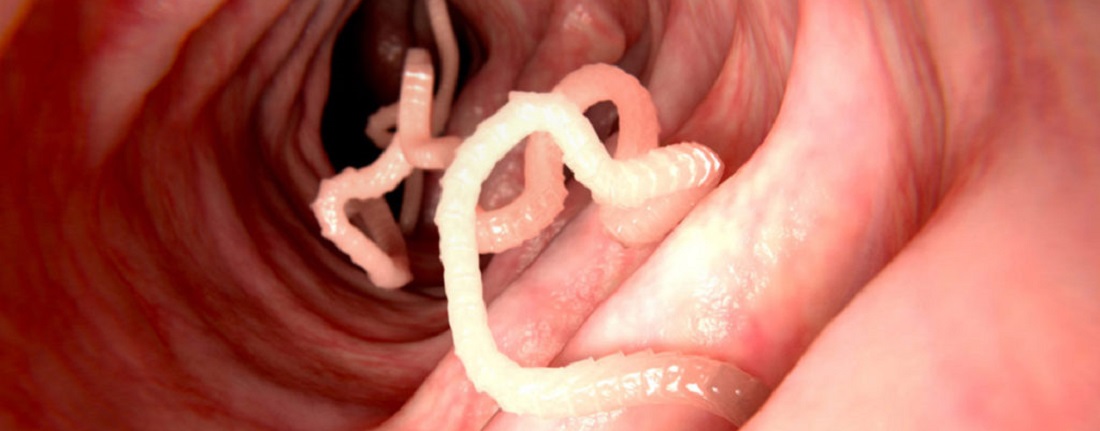
Types of tapeworms that can infect humans include:
- Taenia saginata (beef tapeworms) are usually 4-12 m in length but can grow to be more than 25 meters. The adult tapeworms produce 1,000 to 2,000 proglottids (a segment of a tapeworm containing both male and female reproductive organs) and may produce up to 100,000 eggs per proglottid.
- Taenia solium (pork tapeworms) are smaller, and can measure 2-8 m in length, produce an average of 1,000 proglottids, and may produce 50,000 eggs per proglottid.
- Taenia Asiatica (Asian pork tapeworm) tapeworms range in size and can measure from 4-8 m, produce 700 proglottids, and may produce 80,000 eggs per proglottid.
- Hymenolepis nana (dwarf tapeworm) adults measuring 15 to 40 mm in length
- Diphyllobothrium latum (the fish or broad tapeworm). They are the largest parasite known to infect humans, as the adults can reach up to 15 meters in length, with more than 3,000 proglottids. One worm can produce up to 1,000,000 eggs per day.
- Echinococcus granulosus (dog tapeworm). The adult tapeworm ranges in length from 3 mm to 6 mm and has three proglottids.
- Hymenolepis diminuta (rat tapeworm), adults measuring 20 to 60 cm in length (5, 9, 16, 17, 18, 19, 20).
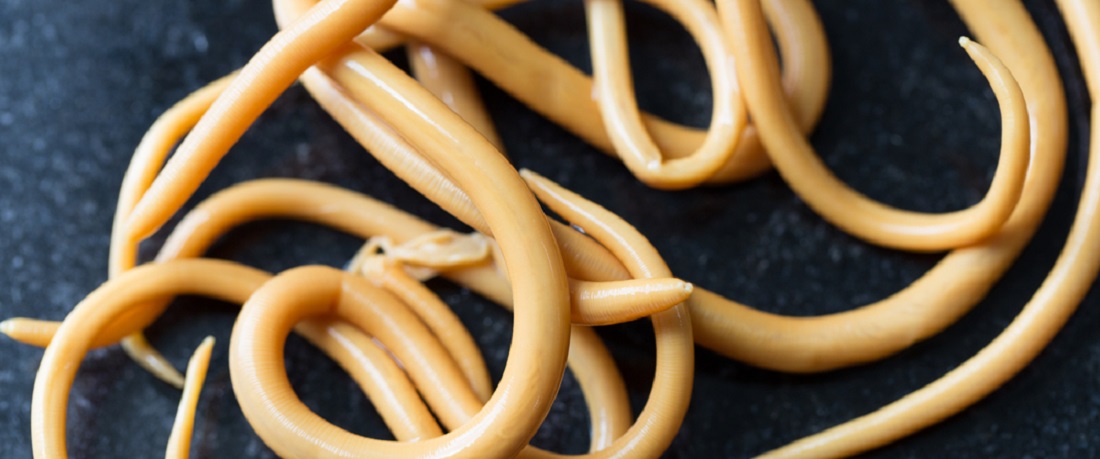
2. Roundworms (Nemathelminthes)
Roundworms, also called nematodes are any worm of the phylum Nematoda. Depending on the type, roundworms can be of different sizes, but they all have round bodies. The adult states of these worms can live in the lymphatic system, gastrointestinal tract, subcutaneous tissues, or blood. In the human intestine, roundworms can live for a long time. But, the immature (larval) forms of roundworms can cause disease through their infection of several different body tissues.
Generally, the eggs or larvae (newly hatched roundworms) residue in the infected stool (poop) or soil, and roundworm infections mostly come from traveling to areas with poor hygiene and sanitation. However, kids can get them elsewhere too. Roundworms can be damaging and cause numerous problems, including fever, abdominal (belly) pain, and diarrhea. A roundworm can produce as many as 200,000 eggs in a single day
Types of roundworms in humans include:
- Pinworms.
- Hookworms (8).
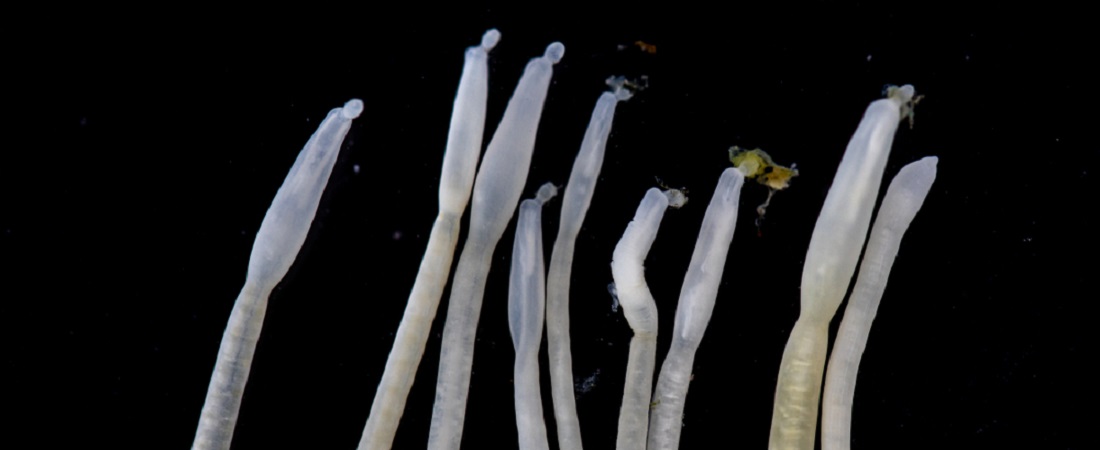
3. Thorny-headed worms (Acanthocephala)
Thorny-headed worms, also known as spiny-headed worms, or acanthocephalans, are a phylum of parasitic worms known as acanthocephalans. These types of parasitic worms are characterized by the presence of an eversible proboscis, armed with spines. Thorny-headed worms use it to pierce and hold the gut wall of their host. The adult forms of these parasites live in the gastrointestinal tract – within the small intestines. Thorny-headed worms are considered to be intermediate between the cestodes and nematodes (5).
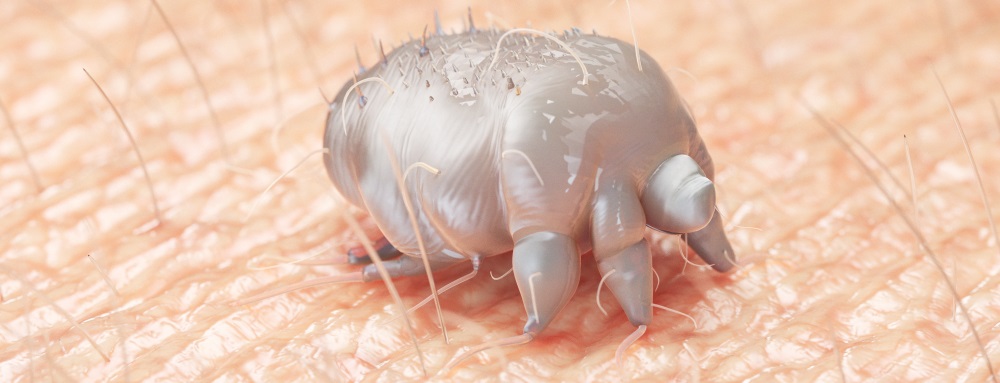
3. Class – Ectoparasites
Ectoparasites are multicellular organisms that live on the skin of a host, from which they derive their sustenance. Although the term ectoparasites can broadly include blood-sucking insects such as mosquitoes (as they are dependent on a blood meal from a human host for their survival), this term is generally used more narrowly to refer to organisms that attach or burrow into the skin and remain there for relatively long periods (e.g., weeks to months). In humans, ectoparasites are comprised of two major animal groups: parasitic arachnids and parasitic insects (10).
Parasitic arachnids include:
1. Ticks (suborder Ixodida)
Adult ticks are approximately 3 to 5 mm in length depending on age, sex, species, and “fullness”. Ticks are external parasites, living by feeding on the blood of mammals, birds, and sometimes reptiles and amphibians. Small amounts of saliva from the tick may also enter the skin of the host animal during the feeding process. If the tick contains a pathogen, the organism may be transmitted to the host animal in this way.
Generally, tick populations tend to be higher in elevation, in wooded and grassy areas where the creatures they feed on live and roam. Deer ticks live in moist, shady areas at ground level. They will cling to tall grass, brush, and shrubs, usually no more than 18-24 inches off the ground. They also live in lawns and gardens, especially at the edges of woods and around old stone walls.
Diseases that ticks may transmit include:
- Anaplasmosis
- Babesiosis
- Borrelia miyamotoi disease
- Borrelia mayonii disease
- Ehrlichiosis
- Lyme Disease
- Powassan Virus Disease
- Rocky Mountain Spotted Fever (RMSF)
- Tularemia (11).
2. Mites
Mites are small eight-legged arthropods that are close cousins with spiders and ticks. Most mites are tiny, less than 1 mm (0.04 in) in length, and have a simple, unsegmented body plan. Some mites live in people’s skin, e.g. the mites that cause scabies. Other mite species and ticks may take blood- meals on humans. You can find mites virtually anywhere, hidden among stacks of papers, tucked in your bedding, in carpets, air ducts, dusty attics, and even on lampshades and frolicking in your dirty laundry. The only infectious diseases transmitted by mites are rickettsialpox and scrub typhus.
Exposure to mites can lead to patches of small, red bumps on the skin accompanied by the following respiratory symptoms:
- nasal congestion and sneezing.
- itchy, red, or watery eyes.
- itchy nose, mouth, or throat.
- a cough.
- chest tightness.
- difficulty breathing.
- wheezing (12).
3. Chiggers
Chigger bites are itchy red bumps that can look like pimples, blisters, or small hives. They are usually found around the waist, ankles, or in warm skin folds. They get bigger and itchier over several days and often appear in groups. You can also get relief if you take antihistamine pills or use a cold compress. Chigger bites usually get better on their own.
4. Scabies (Sarcoptes scabiei)
The microscopic scabies mite burrows into the upper layer of the skin where it lives and lays its eggs. The most common symptoms of scabies are intense itching and a pimple-like skin rash (13).
Ectoparasitic insects include:
- Mosquitoes.
- Tsetse flies.
- Fleas.
- Lice, including the body louse (Pediculus humanis), pubic louse (Phthirius pubis), and head louse (Pediculus humanus capitis).
- Bed bugs (Cimex lectularius).

How To Prevent Getting Parasites
It’s always easier to prevent parasites than to get rid of parasites. Luckily, there are some things you can do to prevent parasitic infections. For example:
- When eating raw vegetables, berries, fruits, wash them thoroughly.
- Always wash your hands with soap before meals.
- Avoid eating raw fish and meat, and eat all your fish and meat products properly cooked or fried.
- Protect all food products from dust, flies, and rodents.
- Ensure that there are no toilets, rubbish holes, or the like in the vicinity of the water distribution areas.
- Keep your own and your pet toilets clean.
- When traveling, drink water from store-bought water bottles and keep anti-parasite and stomach-friendly supplements on hand.
- The best treatment for parasites is continuous prophylaxis.
Most of all, there is no point in bothering your head with the question of whether I do or don`t have parasites. If possibly nine out of ten people have parasites, you can hardly be the lucky one who doesn’t have any parasites in your body. However, analyzes are expensive and some conventional antiparasitic medication can be possibly too toxic for your whole body to perform it just in case.
It must be also said that some specialists believe that any treatment (medication, folk medicine, or other methods) in the presence of parasites will not work unless you first cleanse your body. So they suggest body cleansing courses not only for people who have a parasitic infection but for all of us from time to time to prevent the development of parasites and diseases in the event of infection.
Your Body’s Defense Mechanisms Against Parasites
It is also believed that parasites have a place in the world and they come to our bodies to break down and remove substances that are harmful or not digested in the gut. Therefore, if you make sure that the food you eat is clean and suitable for your body, then your body does not need parasites.
The normal and healthy immune system has sufficient defense mechanisms (eg phagocytic cells (a type of immune cell that can surround and kill microorganisms, ingest foreign material, and remove dead cells), acidic gastric juice, secretions such as tears, fluid, mucus, urine, protection of dead epithelial cells, fat, etc.) against invaders and pathogens.
So, the best protection against tapeworms is considered to be the normal and healthy intestinal microflora, which is produced by eating natural and raw foods.
Some even believe that modern humans become so easily infected with many parasites because they consume too few wild plants, berries, and fungi that are rich in natural antimicrobial, parasitic, and antiviral agents.

Nutrition and Diet During Eliminating Parasites
- When decontaminating parasites, it is important to follow a balanced diet that is high in nutrients. Nutrient-rich foods are important for strengthening the immune system to restore the nutrient deficiency caused by parasites.
- It is especially important to eat high-fiber food during the cleansing course, as the fibers increase the amount of residual mass, which helps to capture the parasites and keeps the regular excretion of residual mass during the cleansing of the intestine. Therapists say that a course of parasites combined with probiotics will help protect the body from future infections.
- Some therapists and nutritionists recommend a cereal- and sugar-free diet during the cleansing course. Some suggest that in addition to reducing sugar, you should also restrict the consumption of fruits, as fruit sugar is also an energy source for parasites.
- During the cleaning cycle, reduce or remove completely refined sugars, yeast products, and junk food from the menu.
- To prevent further infections, it is advisable to avoid eating raw and undercooked meat and seafood and to observe hygiene requirements.
- Parasites are well controlled by naturally occurring antiparasitic agents, which are easiest for the body to ingest with food. Include in the menu the appropriate veggies and fruits (carrots, cabbage, radishes, horseradish, pineapple, rhubarb, etc.), berries (figs, goji berries, etc.), seasoning spices (garlic, onion, oregano, cloves, etc.), and medicinal plants (aloe, day hat, etc.). The most commonly used plants to control parasites are tansy, mugwort, cloves, walnut leaves – when used together, they can kill 100 species of parasites. See the list of antiparasitic herbs and foods below.
- Always take an anti-parasite course for the whole family at once.
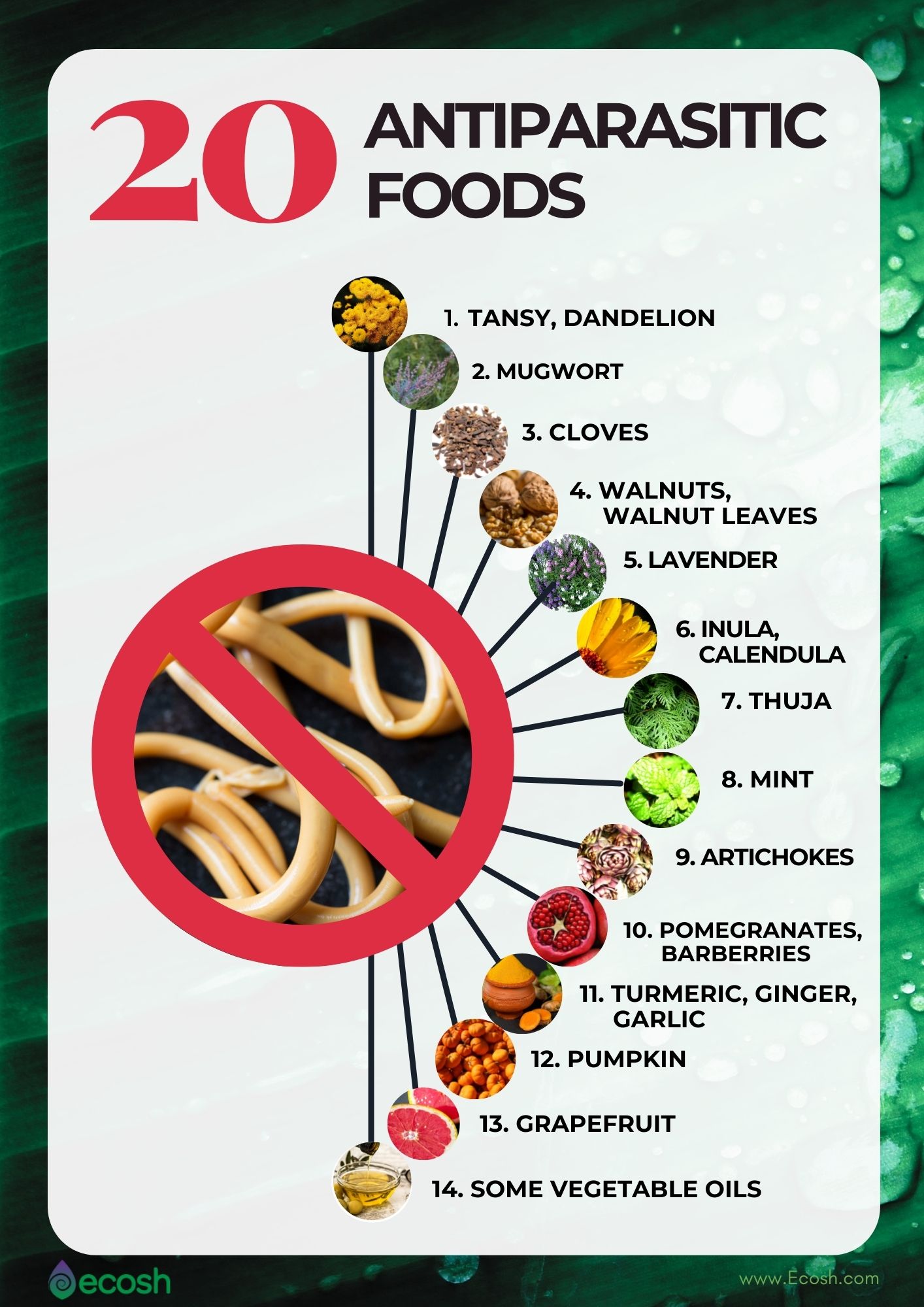
How To Get Rid of Intestinal Parasites in Your Body Naturally?
Although parasites must be destroyed, they are difficult to detect in the laboratory, as the tests might be very expensive or of low certainty. In America, for example, the majority of adults have parasites and they don’t know it.
That said, parasites can be well controlled by natural antiparasitic agents, which are easiest to administer with food. You can include in your daily diet certain antiparasitic herbs, medicinal plants, vegetables, fruits, berries, and spices that are used in cooking since ancient times.
The most commonly used antiparasitic herbs include tansy (Tanacetum vulgare), mugwort (Artemisia vulgaris), cloves, and walnut leaves – when used together, these herbs may kill up to 100 species of parasites.
The List of Antiparasitic Herbs and Foods – 20 Plants That Parasites Don’t Like
If you suspect you might have parasites in your body, you may want to try to consume more of these herbs, and foods that may kill parasites.
- Tansy (Tanacetum vulgare)
- Mugwort (Artemisia vulgaris)
- Cloves
- Walnut leaves
- Lavender
- Mint
- Barberries
- Thuja
- Inula
- Walnuts
- Artichokes
- Pomegranates
- Pumpkins and pumpkin seeds (pumpkin seeds immobilize the nodules and help expel them from the gut)
- Grapefruit
- Hidden-lilies, also called Curcuma, is a genus of plants that contains such species as turmeric and Siam tulip (affects parasites with four substances)
- Dandelion
- Calendula
- Garlic
- Ginger (the last four plants have a particularly strong effect, even destroying the parasites’ eggs and larvae)
- Vegetable oils obtained by cold pressing also have strong antiparasitic properties. Particularly strong oils include walnut oil, alum, grape seed oil, cedar oil, milk thistle oil, flaxseed oil, and apricot oil.
How To Use Antiparasitic Herbs, Plants, and Foods
- You can use these natural antiparasitic herbs, plants, and foods while cooking, for example in salads.
- You can use these plants listed above also to make tinctures based on oil, honey, vodka, or wine (alcohol itself helps to expel parasites). However, the doses required to expel parasites must be quite high and can therefore sometimes cause nausea.
Interesting Facts
- The Japanese do not become infected with parasites when they eat raw fish, because together with sushi – they also eat pickled ginger.
- It is also found that parasites are more common in people who do not like and do not consume the herbs, spices, or foods mentioned above.
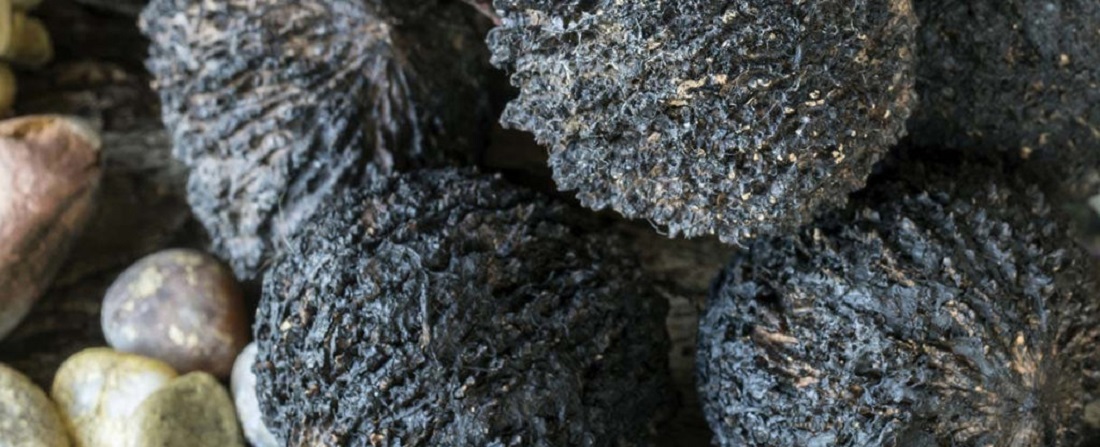
Selection Of Natural Antiparasitic Supplements
Although, there is no warranty or scientific evidence that any of these natural supplements will work against intestinal parasites – some people have found black walnut extract, and Para-Herb together with fiber rich intestinal detox helpful.
1. Black Walnut Extract
In North American folk medicine, Eastern Black Walnut has been highly valued thanks to the effective action of its natural ingredients. It contains polyphenols, juglone, carotene, vitamins C, B1, B6, F, E, as well as essential oils, organic acids, tannins, and other substances. Black Walnut Extract helps to cleanse the body, supports the work of the digestive tract, and strengthens the immune system.
Black walnut is particularly rich in vitamin C, which makes it an excellent antioxidant. It protects your body from the harmful effects of free radicals and is useful for people suffering from exhaustion. Black walnuts contain eight times more vitamin C than black currants and fifty times more than citrus fruits.
The active ingredient juglone contained in Black Walnut Extract helps to purify your body from parasites, fungi, and harmful bacteria, and the active ingredient tannin helps to prevent the development of malignant processes in the gastrointestinal tract. Tannins help to form an impenetrable film in the intestines that isolates mucous membranes from damage and infections. It helps to strengthen your body’s immune system.
Eastern Black Walnut Extract:
- Eliminates the body from parasites (parasites, fungi, harmful bacteria)
- Effectively supports intestinal function
- Strengthens the immune system
- Enhances blood production and purification
- Helps maintain normal cholesterol, blood pressure, and blood glucose levels
How To Use Black Walnut Extract?
Suggested use: Take 1-2 capsules a day (if needed, 1-2 capsules twice a day) with meals or as recommended by your therapist or doctor. Take with water, and do not use for longer than 2-3 weeks.
Caution: Talk to your doctor if you are pregnant, nursing, or taking any medications before using this product. Do not exceed the stated recommended daily dose.

2. Para-Herb
Anti-parasitic supplement Para-Herb contains eight best-known anti-parasitic bitter-tasting plants and one of the best anti-parasitic fungi. This way you can consume these bitter anti-parasitic plants in a modern, comfortable way – in the form of capsules without feeling an unpleasant bitter taste.
9 Plants Contained in Para-Herb:
1. Black walnut leaves (Juglans Nigra)
Various bitter parts of the black walnut tree have antibacterial and anti-inflammatory effects. The plant contains polyphenols, juglone (also called 5-hydroxy-1,4-naphthalenedione), carotene, vitamins B1, B6, F, E, essential oil, organic acids, tannins, and other substances. Juglone is the main active ingredient in black walnut, which is effective against bacteria, fungi, tapeworms, helminths, and worms. The concentration of juglone and polyphenols in black walnut leaves is 2-4 times higher than in walnut.
2. Chanterelle (Cantharellus Cibarius)
The most wonderful feature of this fungus is the ability to cleanse the body of almost all parasites. They help with helminths, ie. fight virtually all worms in the human body, wherever they nest. The substance quinomanosis in fungi kills parasites, surrounds parasite eggs, and dissolves their shells. This unique property is a knowable characteristic to only Chanterelle.
3. Olive leaves (Olea Europaea)
Parasites are quite difficult to kill and expel, but studies are promising on olive leaf extract with other antiparasitic plants, confirming that olive leaves are anti-viral, anti-bacterial, antifungal, and antiprotozoal. Olive leaf extract also fights other dangerous microbes.
4. Caraway (Carum Carvi)
Caraway is rich in essential and fatty oils (about 3-7%), and tannins, as well as bitter substances, make caraway an excellent digestive aid. Its essential oils relieve abdominal cramps and bloating, soothe the stomach, and stimulate appetite.
5. Clove (Caryophyllus Aromaticus)
Cloves contain essential oils, the most important of which is eugenol. In Southeast Asia, it has been used to treat many diseases for thousands of years. Cloves have antiseptic, antibacterial, and parasiticidal properties. They help prevent viral, bacterial, and fungal infections and drive out parasites. Eugenol has a strong anti-inflammatory effect. In addition, it fights bloating and gases, cleanse the liver, spleen, and skin, as well as has a calming effect on the digestive tract,
6. Yellow Gentian (Gentiana Lutea)
The roots of yellow gentian have anti-inflammatory and anti-putrefaction properties and they help to expel intestinal parasites. Some people use these roots to help with liver and especially digestive problems, as well as to cure loss of appetite and weakness. Due to its bitter taste, it stimulates digestive activity and increases appetite. It also has antifungal effects, helps fight muscle wasting, bloating, low acidity of gastric juice, and low bile secretion.
7. Cat’s Claw (Uncaria Tomentosa)
Cat’s claw is used to treat viruses, parasites, and inflammatory processes. In addition, it reduces EBV and its cofactors, streptococci A and B.
8. Wormwood (Artemisia Absinthium)
Folk medicine practitioners use wormwood to eradicate intestinal parasites. Wormwood increases appetite, reduces intestinal and gastric gases, digests, and eliminates diarrhea or persistent constipation. In addition, it also helps with liver disease and metabolic disorders and eliminates bad breath.
9. Tansy (Tanacetum Vulgare)
Tansy is a highly toxic plant for internal parasites. Herbalists have been prescribing tansy herbal teas for centuries to expel worms. This herb is an effective insecticide and is very toxic to arthropods.
How To Use Antiparasitic Supplement Para-Herb?
Suggested use: Take 4 capsules a day 10 minutes before a meal or as advised by your doctor. Take with a glass of water. Start taking 1-2 capsules a day, and increase the dosage gradually. It’s because too fast and too many antiparasitic agents can create parasite resistance by secreting toxins from the body and increasing reproduction. This in turn can manifest as flu-like symptoms such as nausea, vomiting, diarrhea, abdominal cramps, and headache. Recommended period of use:
- 1. PHASE: 10 days, 2 x 2 capsules a day, 5 days pause
- 2. PHASE II: 10 days, 2 x 2 capsules a day, 5 days pause
- 3. PHASE III: 10 days, 2 x 2 capsules a day
The total length of the administration period is 40 days. Together with Para-Herb, eat fiber-rich foods or consume Fiber-rich Intestinal Cleansing Detox.
Caution: Be sure to monitor your well-being, as people’s health conditions are different. Do not use in case of pregnancy and lactation and in case of hypersensitivity to any of the ingredients. In case of peptic ulcer disease, gastric hyperacidity, gastritis, blood pressure, thick blood (when taking blood thinners), kidney failure, and other more serious illnesses, consult a doctor or therapist. In children, consumption depends on the child’s age and weight, but on average 1-2 capsules a day. Together with the Para-Herb product, it is recommended to provide children with high-fiber food, which helps to expel parasites.

3. Fiber-Rich Intestinal Cleansing DETOX
Along with the Para-Herb product, we recommend eating high fiber foods or consuming a fiber-rich intestinal cleansing detox, as the fibers in this product expand into a multiple gel mass in the intestine, which absorbs residues, parasites, and toxins and then expels them gently. After destroying and removing parasites, it is necessary to restore and strengthen the normal intestinal microflora.
Intestinal cleansing Detox also contains 12 different probiotic strains that support and protect your intestinal microflora. Probiotics also help absorb nutrients. The function of probiotics is also to keep the number of pathologists (bad bacteria, fungi, pairs) under control, but they need a sufficient number of colonies to perform their function.
How To Use Fiber-Rich Intestinal Cleansing DETOX?
Suggested use: Take 1 tablespoon of fiber with 1-2 glasses of water in the morning immediately after waking up or in the evening before going to bed, but be sure to schedule Para-Herb capsules and fiber at different times so that the fiber does not absorb Para-Herb herbal powder. For constipation or hemorrhoids (be careful with fibrous hemorrhoids), take fiber in the morning and consume plenty of water 1.5-2 liters during the day.
NB! The information provided here is for informational purposes only, so do not consider it as health care or medical diagnosis and treatment. Do not consider this information as a guarantee of the results you want to achieve. In addition, do not take this information as a replacement for the advice of your physician or other healthcare professional.
Even more, you should not use it to diagnose or treat a health problem. Before changing or discontinuing your existing medication, treatment, or care, or taking any dietary supplements, be sure to consult with your healthcare professional or doctor before starting any diet or program, or if you suspect you may have a medical condition.
Written by Maria-Helena Loik
Pictures: Pexels.com, Pixabay.com, Shutterstock.com
Sources:
- Parasitic Infections – Sepsis Alliance
- CDC – Parasites – Parasitic Transmission
- Intestinal parasites Information | Mount Sinai – New York
- Protozoa (cliffsnotes.com)
- CDC – Parasites – About Parasites
- The flagellum of trypanosomes – PubMed (nih.gov)
- Entamoeba Histolytica – an overview | ScienceDirect Topics
- Roundworms: Parasitic Infection, Pinworm Symptoms, Treatment (clevelandclinic.org)
- Ectoparasite – an overview | ScienceDirect Topics
- Ectoparasite Definition and Examples – Biology-Online Dictionary
- Diseases Transmitted by Ticks – Minnesota Dept. of Health (state.mn.us)
- Mite bites: Symptoms, treatment, and different bites (medicalnewstoday.com)
- Mite‐Transmitted Dermatoses and Infectious Diseases in Returning Travelers | Journal of Travel Medicine | Oxford Academic (oup.com)
- Association of Fasciola hepatica Infection with Liver Fibrosis, Cirrhosis, and Cancer: A Systematic Review (nih.gov)
- Taeniasis/cysticercosis (who.int)
- Tapeworm – PubMed (nih.gov)
- Tapeworm infection – Symptoms and causes – Mayo Clinic
- CDC – Taeniasis – Resources for Health Professionals
- CDC – Diphyllobothrium – Biology
- Flukes | Encyclopedia.com
- CDC – Toxoplasmosis – General Information – Frequently Asked Questions (FAQs)
- What You Need to Know About Parasites (ccfmed.com)
- Parasitic infections of the lung: a guide for the respiratory physician | Thorax (bmj.com)
- Lymphatic filariasis (who.int)
